Women’s sevens was showcased wonderfully at Rio 2016, with the craft of Charlotte Caslick inspiring Australia to the title.
Question: What do rugby league rockstar Shaun Johnson, World Cup-winning All Black Nehe Milner-Skudder and Charlotte Caslick, catalyst of Australia women’s sevens triumph at the Olympic Games, share in common? Answer: All three excelled in touch rugby before shooting up the full-contact ranks.
Plenty still sneer at the transitional form of the game. However, when contested keenly, it hones a variety of attributes. Johnson and Milner-Skudder have collected innumerable YouTube hits due to highlight reels of mesmerising footwork, but touch also encourages organisation, sharp handling, perceptive support lines and spatial awareness.
For sheer romance, the dominant victory of Fiji’s irrepressible men in Rio de Janeiro was intoxicating. Leone Nakarawa and his ludicrously talented teammates will have captured the hearts and minds of many. However, the women’s tournament may provide rugby with a bigger breakthrough in terms of encouraging participation.
Given the first chance to promote their sport on its Olympic return, the players delivered a compelling, high-quality event. When the dust settled, Australia were worthy champions. Here is a brief look at how Caslick shone as part of an excellent unit.
Knowing roles and picking holes
Fewer players means more open space in sevens, which obviously stretches cardiovascular capacity. There is constant mental strain too. Positional constraints are far looser, meaning players must adopt different responsibilities and adapt on the job in a fluid manner.
During the build-up to Australia’s third try in their quarter-final defeat of Spain, a dogged and tenacious outfit, such collective quick-thinking is in plain view. We begin with a scrum on Australia’s five-metre line.
Caslick, an extremely versatile operator as highlighted later in this piece, starts in the scrum-half position from the set piece. Alicia Quirk, the second chief playmaker for Australia, stands directly behind the scrum:

Tapping hooker Shannon Parry…
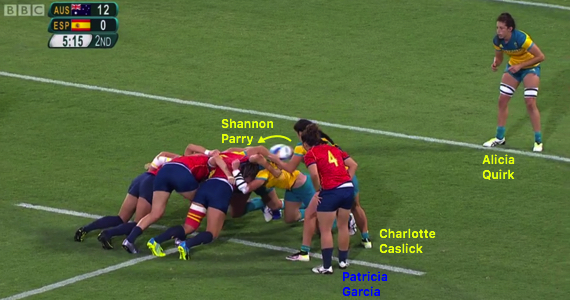
…Caslick puts the ball in and a clean strike meets it:
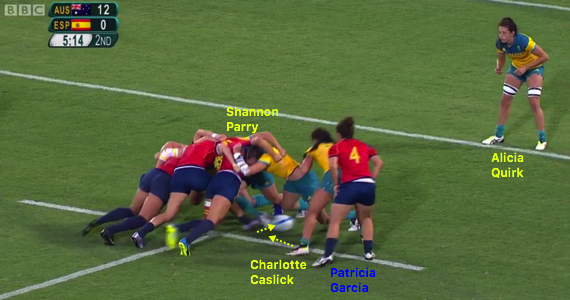
Prop Chloe Dalton does well to control, protecting possession from Spain scrum-half Patricia Garcia, allowing Caslick to stoop…
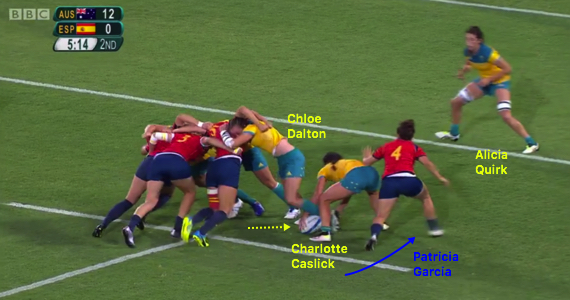
…and locate Quirk:

A reputation for fast, frantic exchanges does not mean that there is not a place for direct running in sevens. Sure enough, as Quirk arcs infield, Emilee Cherry cuts a narrow angle and launches an abrasive carry.
Crucially, Cherry aims at a gap rather than actively seeking a collision. This increases the chances of a weak ‘arm tackle’, giving Cherry a better opportunity of either offloading or puncturing the gain-line.
With two defenders hastily jamming together to halt the run, more Spanish players are likely to be committed to the subsequent breakdown as well:

At this point, Australia’s cohesion really sticks out. This is only the first phase, but everyone is instinctively aware of their individual roles. Supporting Cherry, Quirk follows her pass – a recurring theme of this article – in anticipation of resourcing the breakdown.
Parry and prop Sharni Williams circle beyond the ball to join Emma Tonegato as backline options on the the far side. They trust that Caslick will assume the role of scrum-half. Meanwhile, Dalton emerges from the scrum and stays put – an underrated facet of creating space – to ensure Australia have options on both sides of the ruck:

Tellingly, Caslick glances at the blindside on reaching the ruck. However, Spain set up well. Including hooker Angela del Plan, not needed in the first tackle, three cover the openside. Two more stand on the blindside. Their two remaining players are the tackler and one other, free to compete on the floor:
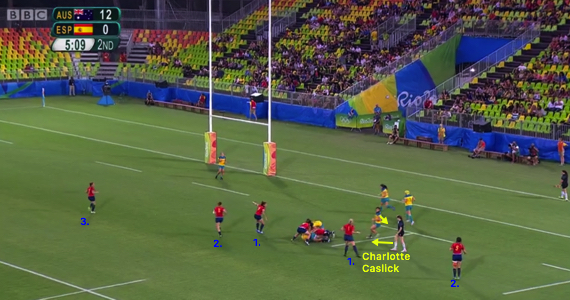
Under the watchful eye of referee Jessica Beard, Quirk clears Patricia Garcia as tackler Vanesa Rial rolls away. Caslick comes in at scrum-half, aided by Cherry’s diligent ball presentation…
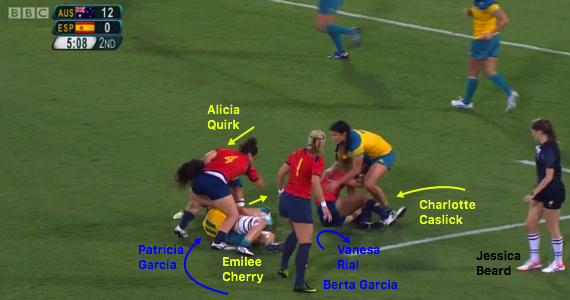
…and moves the ball away again to Parry. Note Patricia Garcia, who contested at the previous ruck, and Berta Garcia, who was posted in the guard position on the blindside, curve back to the left to join the Spanish openside defence:
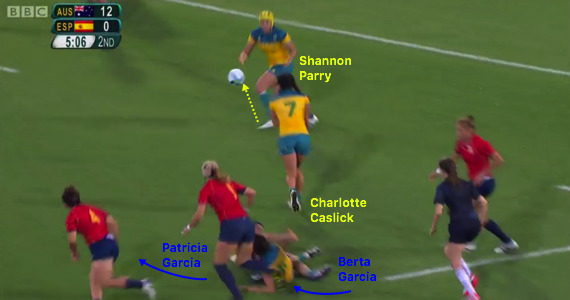
A proactive press from Barbara Pla and del Plan on the wide outside then encourages Parry to cut back against the grain rather than force another pass. But again, she aims for a space rather than a face. Meanwhile, Caslick follows her pass as Quirk did before her:

Maria Casado and Berta Garcia concertina towards one another to stop Parry, who makes 10 metres. Caslick hunts the ball-carrier while two more Australians, Quirk and Cherry, bounce up from the previous ruck. Cherry heads towards the action, with Quirk backing away to offer herself as an outlet from the next breakdown on the left:

Patricia Garcia senses a turnover chance on the floor as Parry is felled by Berta Garcia and Casado…

…but, with Williams calling for a teammate to step in at scrum-half, Caslick swoops with a strong body position…
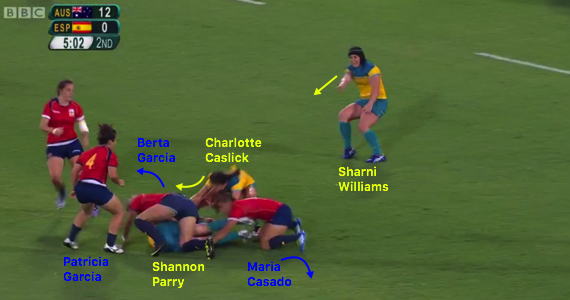
and protects the ball. Patricia Garcia tries to slip around the outside to steal before Cherry arrives…
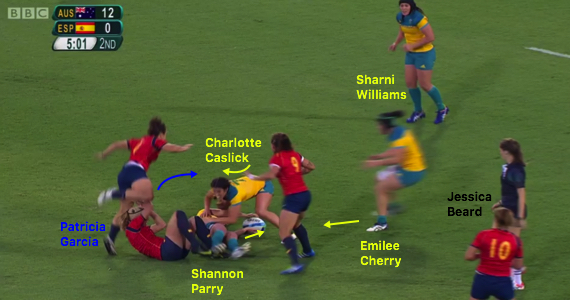
…but is told to back away by Beard:
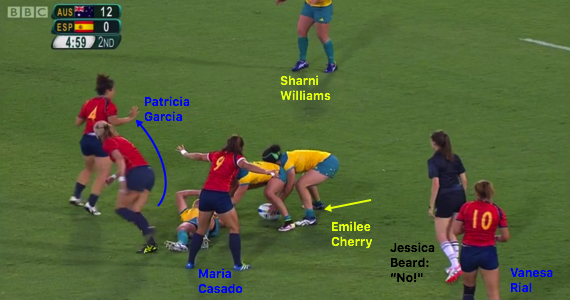
Cherry initially looks to locate Williams on her right, but swivels to her left after perhaps hearing a call:
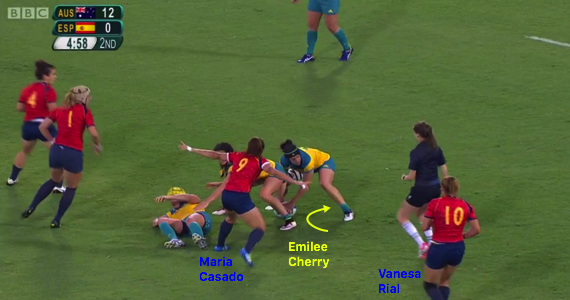
She hits Quirk, back in the game after clearing the first ruck of this attack, stretching the Spanish defence:
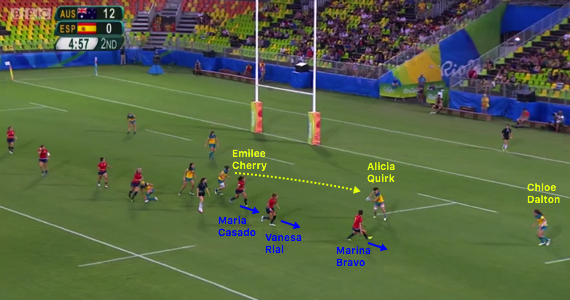
Another pass gives Dalton some room to gallop. The spacing between Rial and Marina Bravo, who is moving close to top speed in an attempt to cover the outside, extends to form a glaring gap:
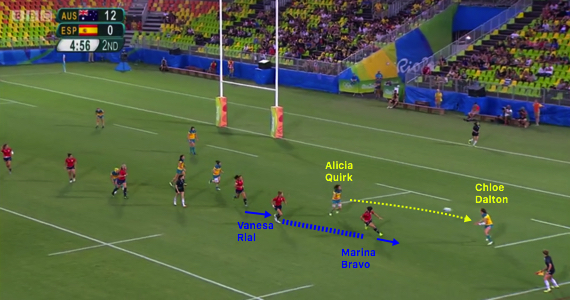
Dalton takes the invitation, stepping infield off her left foot. Circled is Caslick, on her feet again and dropping back in readiness for the next phase:

With Dalton careering over the gain-line through the double challenge of Rial and Bravo, Australia file into their roles once more.
Quirk, the passer, follows the ball to become the clearer. Cherry sweeps across to play scrum-half again. Parry retreats, joining Williams and Tonegato as backline options for Caslick, who co-ordinates matters at first-receiver:

Bravo is tempted to compete at the breakdown, but Quirk is accurate with the clean-out. As Cherry approaches the ball, Caslick keeps an eye on Spain’s defensive structure. Casado is in position quickly and evidently eager to press onto the openside:
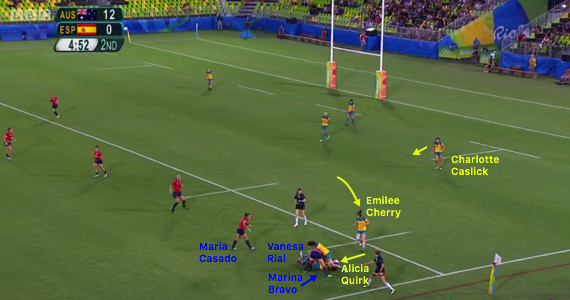
Sure enough, Casado gestures towards Caslick and is ready to hare up:
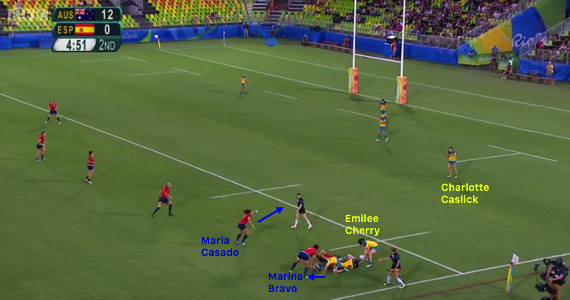
When Cherry finds Caslick, Bravo must push herself away from the ruck and arc around to the left to connect with her teammate. This is the area of weakness in the Spain line.
Further out, they actually have greater numbers – four to three. Should Australia attempt to pass the ball into midfield, Spain could easily crowd out the attacking team and force a turnover:

Caslick sums up the situation and identifies where the space is brilliantly. On catching the ball, she steps off her right foot and back towards the ruck:
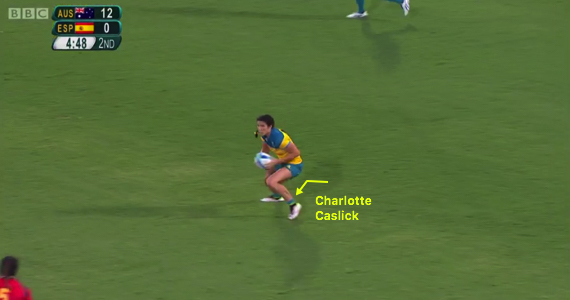
Cherry has followed her pass, with Quirk not far behind her, and this industry – grafting back to makes themselves available to the carrier – helps fashion the try.
Holding the ball in two hands, Caslick shapes to throw back inside and attacks the gap between Casado and Bravo, both of whom have over-chased and must slam on the brakes to change direction:

Caslick chucks a dummy and Bravo buys it, drifting onto Cherry…
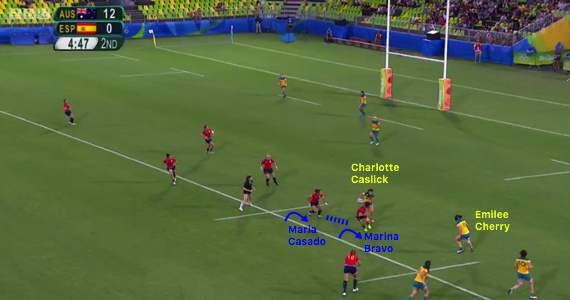
…and being turned inside out as Caslick slips the ball back into one hand, freeing the other in order to engage top sprinting speed:

Casado cannot recover the ground and Caslick canters all the way through to dot down under the posts:

Following this win over Spain, beating Canada brought Australia into the decider against old foes New Zealand. The match turned on one moment.
Loop the loop
This attack also begins at a scrum, Caslick feeding…

…before sweeping around on the hook…
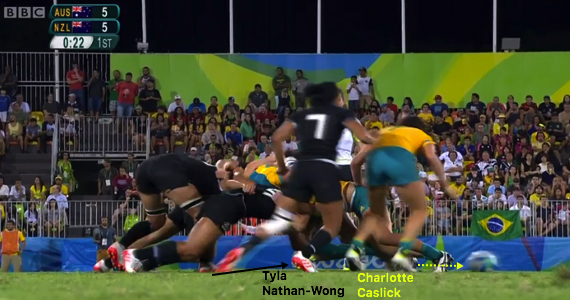
…and popping up the ball to Quirk. New Zealand appear very well organised. Captain and hooker Sarah Goss has already slipped from the scrum to join the line, while Tyla Nathan-Wong is harrying as well:

Kayla McAlister rushes up in midfield to cut down Australia’s room but Quirk is nerveless. She takes the ball forward calmly. Note that Caslick is hunting the carrier again:

Quirk dummies a wide pass to Cherry, which halts McAlister’s line-speed:
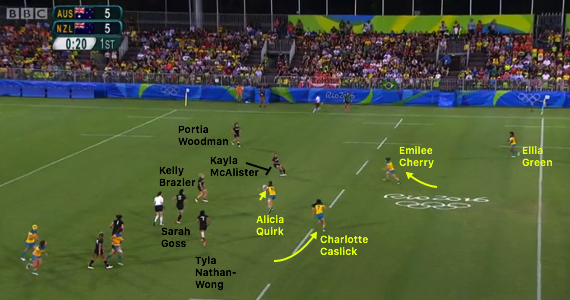
Cherry then changes angle, charging into a short line. Kelly Brazier bites on Quirk at this point, with McAlister standing her ground.
Caslick continues to circle…
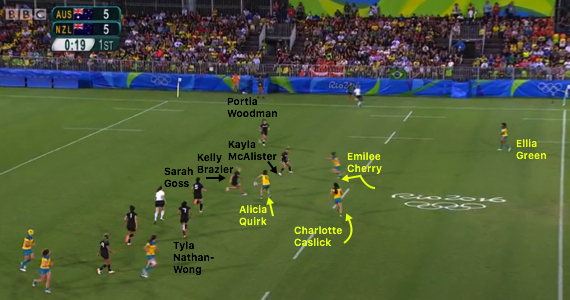
…and receives a pass behind the run of Cherry. McAlister does not buy the decoy line of Cherry though, and is able to pressurise Australia’s playmaker:
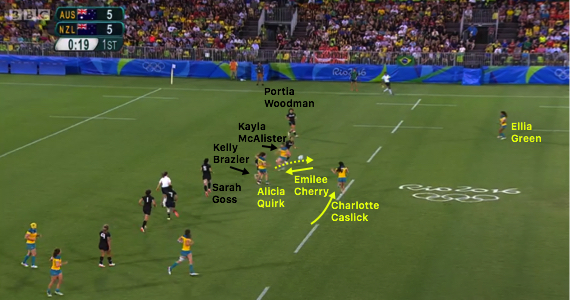
Or at least, she would be if Caslick were not so conscious of space, perhaps thanks to her days in touch rugby. On a wrap-around play, it is very easy to drift across-field on receiving a pass, as indicated by the red line in the screenshot blow.
This serves to cut down space and is easy for the defending side because the attack can be simply shepherded towards the nearest touchline. However, Caslick does not take a lateral route. Instead, she preserves space on the outside by straightening up and attacking McAlister’s right shoulder:

On taking the pass from Quirk, who is looking for ways to support, Caslick steps off her right foot again…
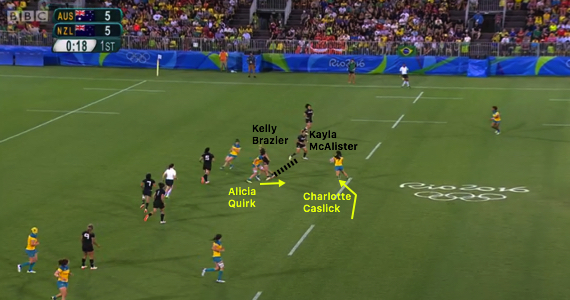
…and attacks the line with energy and conviction, wrong-footing McAlister:
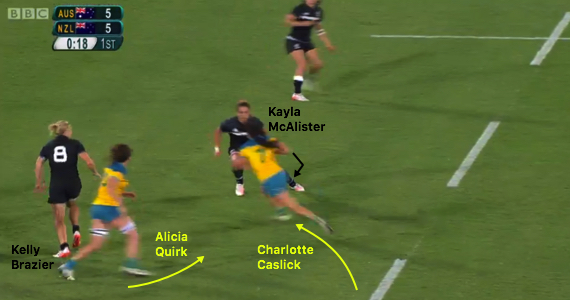
Caslick ties up two defenders while a third, Goss, is impeded by the tackle area as Quirk arrives:
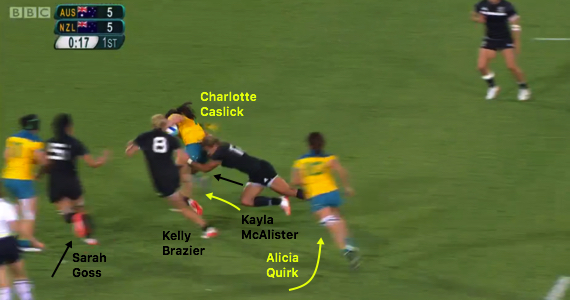
Caslick turns her body in contact, giving herself a full view of Quirk.
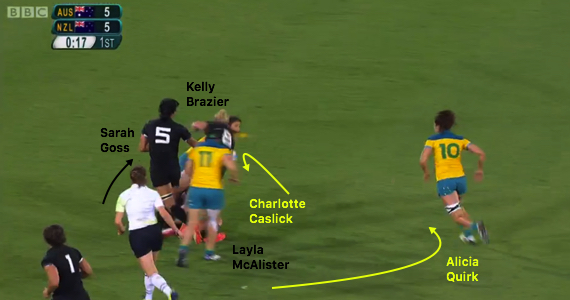
…before releasing an offload…
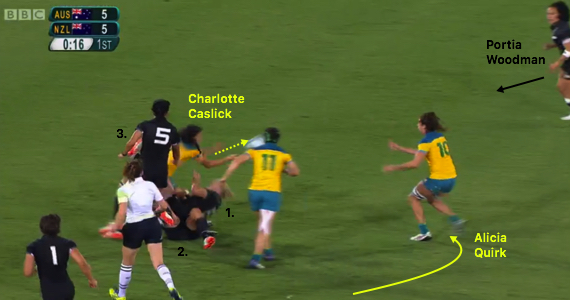
…that floats into her colleague’s path:

Quirk is rewarded for her support and darts into the clear with Portia Woodman moving infield to what looks to be a certain score:
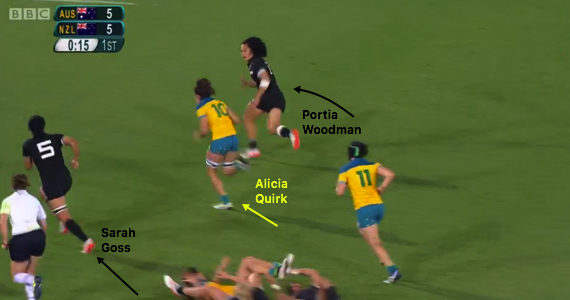
Woodman actually does very well to close down the opportunity. However, Quirk is mindful of Ellia Green storming up outside of her and holds the ball in two hands:
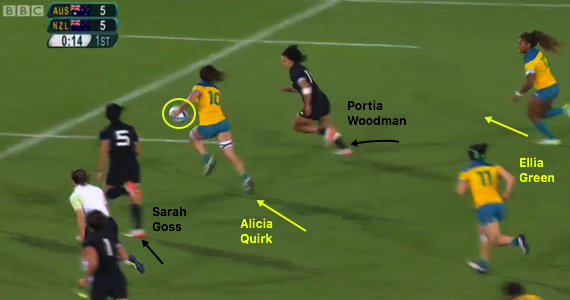
She chooses the moment to release a crisp, accurate pass…
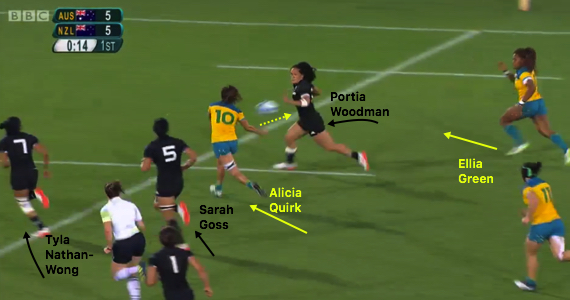
…and, although Nathan-Wong may even have retreated to make the cover tackle, Woodman cannot resist. She sticks out an arm and knocks on:

Referee Alhambra Nievas had no choice but to brandish a yellow card and Australia scored from the next play – a hammer-blow on the stroke of half-time that was rammed home shortly into the second period.
Swerve ball
This final sequence demonstrates both the defensive nous of Australia and the versatility of Caslick – it was not just from the half-back that she influenced proceedings.
That said, the score actually begins with a strong run from the Black Ferns’ Goss. She brushes past Caslick to cross the Australia 22:

But Parry is close by and latches on…
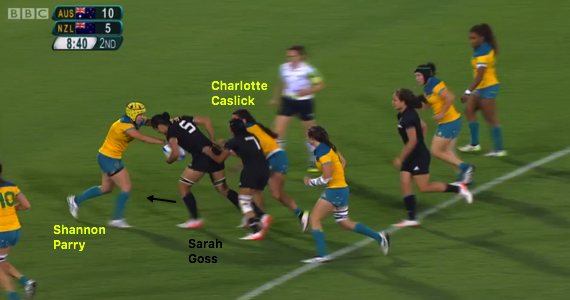
…before using Goss’ bodyweight to bring her down…

…felling Goss with a judo throw of a tackle:
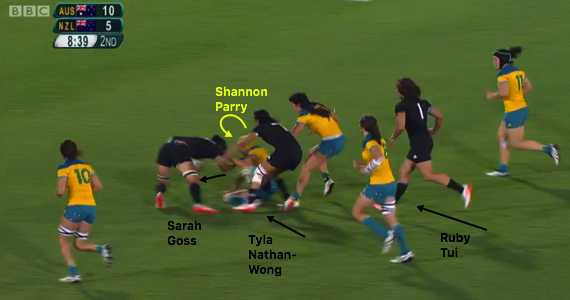
Parry then rolls to her feetand gets over the ball despite the attentions of clearers Nathan-Wong and Ruby Tui. Mindful of conceding a penalty, she does not touch the ball with her hands…
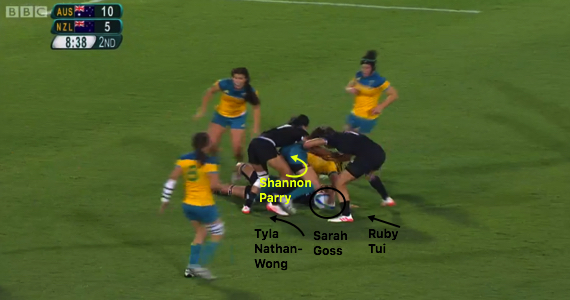
…instead throwing a foot towards it – a tactic England have used to great effect under Eddie Jones – and kicking it clear. Note that Green has retreated to an onside position…
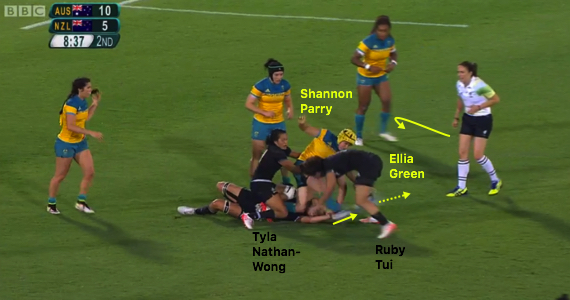
…and can therefore chase the loose ball on its route upfield. Mirroring their instinctive organisation against Spain, Australia’s three closest players are aware of their roles immediately:
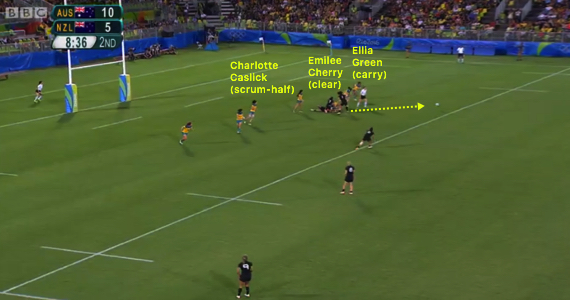
As Green stoops to pick up the ball skilfully, it is worth making a note of the time. Australia do not relinquish possession again until they have scored:
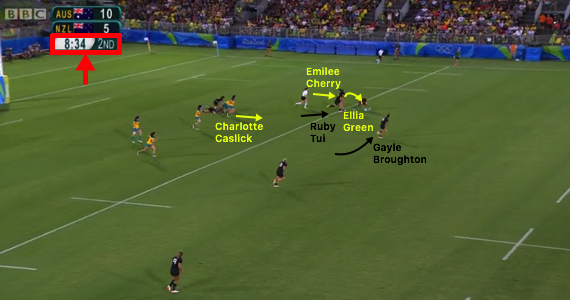
Tui actually recovers brilliantly to tackle Green…

…but Green shows an impressive grasp of the laws, buying herself – and the supporting Cherry – a precious second by releasing the ball, getting back to her feet and picking it up again under close scrutiny from Nievas:
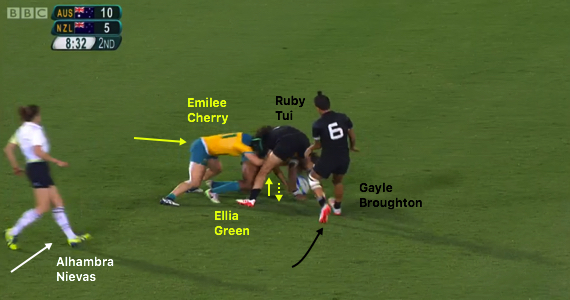
With the ball secure, Caslick arrives to assume scrum-half responsibilities:
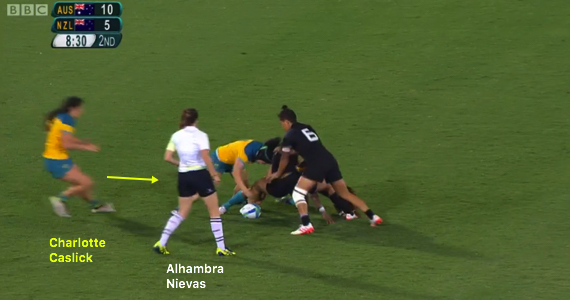
As the clock shows, this next clip comes from two phases later in the same attack. Quirk plays scrum-half, passing to Caslick at first-receiver – the two interchanged superbly throughout the Games. New Zealand again seem to be numbered off well…
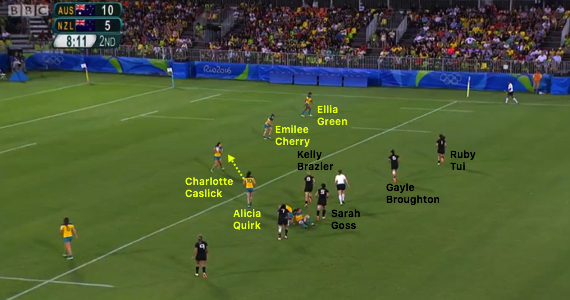
…but a short burst of acceleration from Caslick gets her outside Brazier, creating a three-on-two:
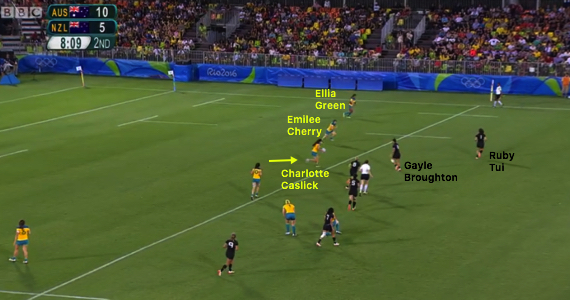
Caslick waits for Gayle Broughton to step in before locating Cherry.
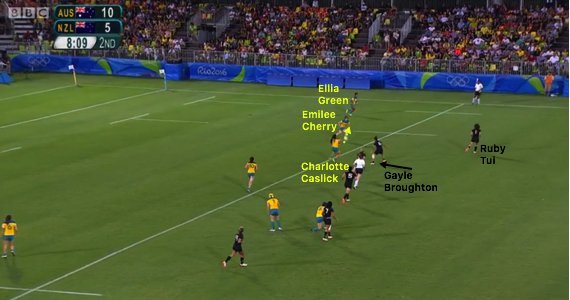
Only a perfectly-timed intervention from Tui, who forces the ball onto the ground in a tackle on Cherry, stops a break down the left wing:
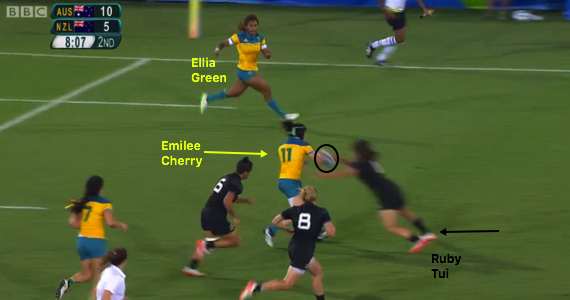
When we pick up the same foray once more, the six New Zealand women have been defending for a continuous passage of 53 seconds. That amounts to a lung-sapping period in sevens, even without their one-player disadvantage.

Reinforcing the versatility of Australia’s backs, this time Quirk finds Cherry, who in turn locates Caslick close to the 15-metre line. Pace and accuracy of passing means Australia have spanned the width of the pitch quickly.
New Zealand cannot exert any pressure and must employ a ‘soft drift’ defensive pattern, effectively heading backwards in an attempt to ease their opponents towards the touchline:
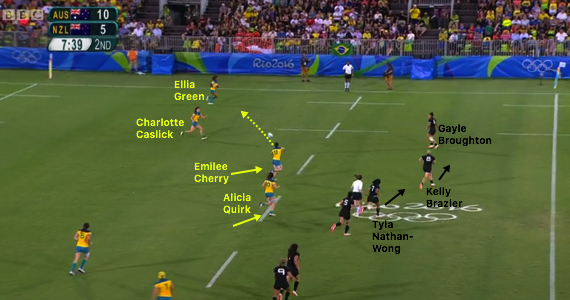
Again, there is a danger for the attacking side to drift in the same direction and run out of room. Again, Caslick takes it upon herself to straighten up. From the reverse angle, this red line shows a line of running that could kill the scoring opportunity:
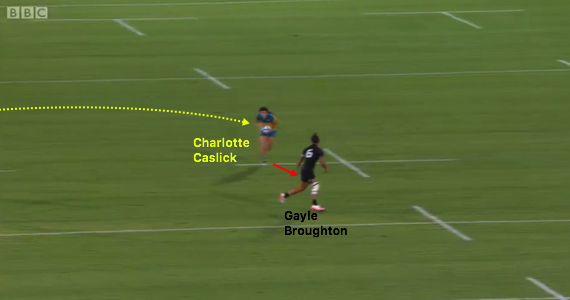
Caslick instead bounces back infield off her left foot, holding the ball in two hands and swerving against the grain:

It would of course be hyperbolic to compare Caslick to Conrad Smith, but this balance and spatial awareness is undoubtedly reminiscent of how the 94-cap centre used to manufacture tries for the All Blacks.
The ball goes back into one hand as Brazier is bypassed…

… and then into two again as Nathan-Wong makes a desperate tackle attempt. As appears to be a fundamental principle of this Australia team – and, by association, of touch rugby as well – Cherry has followed her pass:
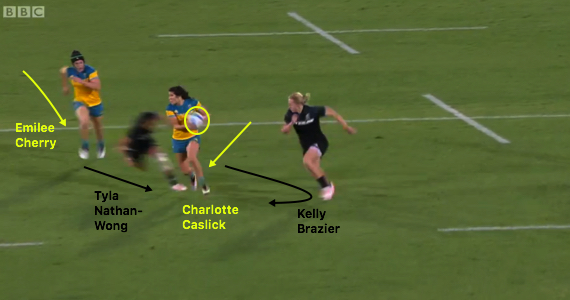
Having halted the defensive slide of two defenders and drawn them in, Caslick turns her body right round, compelling Cherry to run towards the left touchline:
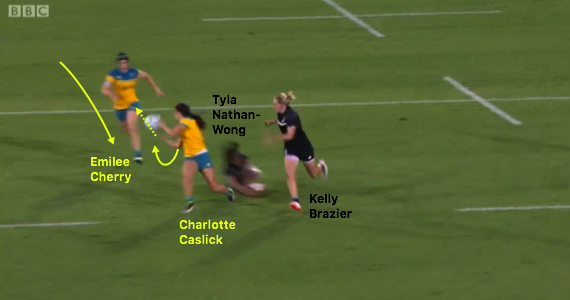
Sure enough, Cherry takes, steps off her right foot instantly…

…and finds huge amounts of space:
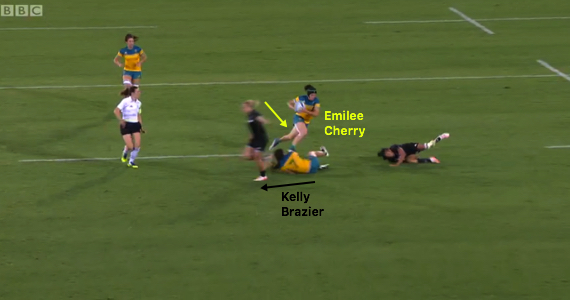
The try-scoring pass to Green is a very easy one:
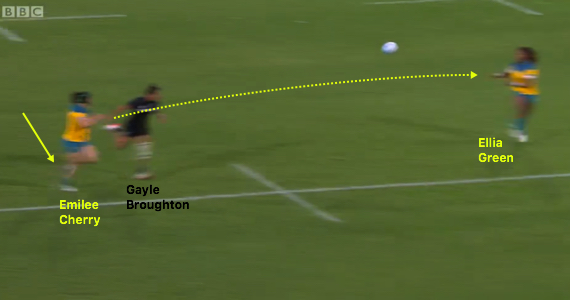
Australia’s march to a gold medal was fuelled by the practice of manufacturing space and moving the ball towards it. Caslick, arguably the chief architect of their achievement, and a number of her squadmates were approached by talent scouts that had been impressed by their touch rugby exploits.
There can be no better case study for prospective players than her story. And anyway, these are lessons to take into any form of the game. Now to hope participation booms on the back of a thrilling Olympic Games.
Graphics created from BBC footage





